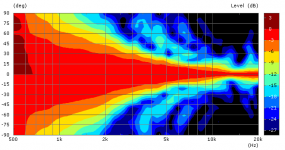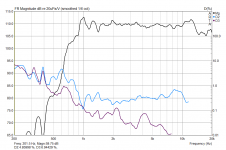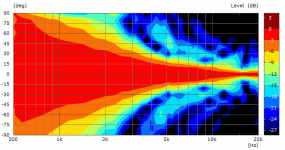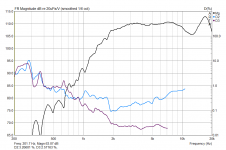[...] As you can see distortion is very low and on the same level as the Beyma. [...] Decay is very good on both drivers. [...]
This is great. Thanks for sharing.
[...] I accidently ran the AMT 4 without a crossover for an hour. I was wondering why the sound was so forward...
Love it! I saw / posted in another thread about someone running B&G Neo8 arrays without crossover - but on purpose. How loud were you running the AMT?
This is great. Thanks for sharing.
Love it! I saw / posted in another thread about someone running B&G Neo8 arrays without crossover - but on purpose. How loud were you running the AMT?
Not too loud, just above normal conversation level. They didnt seem to mind it 🙂
Not too loud, just above normal conversation level. They didnt seem to mind it 🙂
For 100 dB @ 1 m you need about 10 W @ 1 kHz. I already measured at 115 dB with a short sweep. I suppose that short peaks in music with very high levels are no problem for the driver.
Btw. the Beyma TPL-150 is specified with 80 W which is not much more than the Dayton. And its purpose is PA application.
Based on the feedback in this thread, it sounds like I need to design a Synergy Horn for the home with an AMT at the apex.
Hmmm...
A smith horn would make for an easy AMT synergy. Quick to prototype too
Hi, I'm using Dayton AMT PRO 4 in my first attempt at speaker building along with a pair of RS180-4's. I wanted to try technology that wasn't around when I got in Hifi in the 70's, so I have a 12" tapped horn sub too! I'll be posting my efforts anon.
Martin.
![URL]](/community/proxy.php?image=http%3A%2F%2F%5BURL%3Dhttp%3A%2F%2Fs58.photobucket.com%2Fuser%2Fgtirgems%2Fmedia%2FMobile%2520Uploads%2F2016-08%2FIMG_20160809_225903.jpg.html%5D%5BIMGDEAD%5Dhttps%3A%2F%2Fi58.photobucket.com%2Falbums%2Fg253%2Fgtirgems%2FMobile%2520Uploads%2F2016-08%2FIMG_20160809_225903.jpg%5B%2FIMGDEAD%5D%5B%2FURL%5D&hash=558581cf9b05eac38558f081abff8b26)
Martin.
![URL]](/community/proxy.php?image=http%3A%2F%2F%5BURL%3Dhttp%3A%2F%2Fs58.photobucket.com%2Fuser%2Fgtirgems%2Fmedia%2FMobile%2520Uploads%2F2016-08%2FIMG_20160809_225903.jpg.html%5D%5BIMGDEAD%5Dhttps%3A%2F%2Fi58.photobucket.com%2Falbums%2Fg253%2Fgtirgems%2FMobile%2520Uploads%2F2016-08%2FIMG_20160809_225903.jpg%5B%2FIMGDEAD%5D%5B%2FURL%5D&hash=558581cf9b05eac38558f081abff8b26)
One other thing I forgot to mention. It's not really fair to compare the Dayton's to a product 10x more expensive, but given approximately the same diaphragm dimensions, the Dayton's seemed to have a much higher cutt-off than a Mundorf of approximately the same size. I may be misremembering.
Best,
Erik
Best,
Erik
I own a pair of AMTPro-4 and compared it to the Beyma TPL-150.
Would you mind posting the result here? Pics on that forums are only allowed the members from that forums to view, many of us couldn't see those pictures....
No problem. The Dayton AMTPro-4 was coarsely equalized for measuring non-linear distortion, because frequency response is a bit weird out of the box. Distance to microphone was 1 m in the middle of the room (no anechoic environment). Directivity is normalized to 0°.
Dayton AMTPro-4
Vertical directivity:

Non-linear distortion (100 dB):

Non-linear distortion (110 dB):

Beyma TPL-150 (without horn)
Vertical directivity:

Non-linear distortion (100 dB):

Non-linear distortion (110 dB):

Dayton AMTPro-4
Vertical directivity:
Non-linear distortion (100 dB):
Non-linear distortion (110 dB):
Beyma TPL-150 (without horn)
Vertical directivity:
Non-linear distortion (100 dB):
Non-linear distortion (110 dB):
Attachments
Vertical directivity:

I feel like I may have asked you this question before, but what program are you using to plot your polar maps?
I feel like I may have asked you this question before, but what program are you using to plot your polar maps?
I'm using VACS.
Nils, thanks for your pics. If you have chances please grab a pair of Aurum Cantus AST25120, this is the best Aurum tweeters so far (lowest distortion and soomthest frequence among all Aurum tweeters), the second best is AST2560 (at least from paper), the third is APR3.0 but APR3.0 is not in production and seems we can't find it anywhere. I've compared all the datasheets from Aurum tweeters, call me crazy. Really curious about the measurement from the AST25120.
Aurum Cantus AST25120, this is the best Aurum tweeters so far (lowest distortion and soomthest frequence among all Aurum tweeters), the second best is AST2560 (at least from paper).
Do you own both? Can you post your frequency response and distortion measurements?
For 100 dB @ 1 m you need about 10 W @ 1 kHz. I already measured at 115 dB with a short sweep. I suppose that short peaks in music with very high levels are no problem for the driver.
Btw. the Beyma TPL-150 is specified with 80 W which is not much more than the Dayton. And its purpose is PA application.
How do you think they sound?
//
Hi all,
Great thread -I hope that it's still 'alive' 🙂
I'm about to settle on the driver choice for a new speaker that will be using a largish AMT from around 1.5kHz and up. I was about to pull the tricker on the Beyma TPL-150 but would cheerish some inputs from you guys before I make the final call.
Are FoLLgoTT's plots of the Beyma TPL filtered in any way? I ask b/c their' FR seem to drop off downwards more than indicated by Beyma's official plots.
I may have missed it, but are the Beyma and the Dayton AMT PRO-4 measured under similar conditions and implementations? Are they for instance both used as standard, with open or closed back?
Has anyone compared the sound of the Dayton to that of the Beyma?
Also, has anyone compared the Beyma TPL-150 to TPL-150B (or S), or to the TPL-200?
The 200 seem to employ a larger motorsystem compared to the 150s, but besides the slightly larger faceplate on the 150B/S compared to the regular 150, what are the differences between the two?
Many thanks,
Great thread -I hope that it's still 'alive' 🙂
I'm about to settle on the driver choice for a new speaker that will be using a largish AMT from around 1.5kHz and up. I was about to pull the tricker on the Beyma TPL-150 but would cheerish some inputs from you guys before I make the final call.
Are FoLLgoTT's plots of the Beyma TPL filtered in any way? I ask b/c their' FR seem to drop off downwards more than indicated by Beyma's official plots.
I may have missed it, but are the Beyma and the Dayton AMT PRO-4 measured under similar conditions and implementations? Are they for instance both used as standard, with open or closed back?
Has anyone compared the sound of the Dayton to that of the Beyma?
Also, has anyone compared the Beyma TPL-150 to TPL-150B (or S), or to the TPL-200?
The 200 seem to employ a larger motorsystem compared to the 150s, but besides the slightly larger faceplate on the 150B/S compared to the regular 150, what are the differences between the two?
Many thanks,
Are FoLLgoTT's plots of the Beyma TPL filtered in any way? I ask b/c their' FR seem to drop off downwards more than indicated by Beyma's official plots.
I may have missed it, but are the Beyma and the Dayton AMT PRO-4 measured under similar conditions and implementations? Are they for instance both used as standard, with open or closed back?
There was no filter when I measured the drivers. The Beyma was without horn, but with back chamber. For the Dayton I built a small back chamber. So conditions are similar beside the coarse equalization of the Dayton (because its native response is far from beeing flat 😉).
I've tried many of Dayton's AMT and wasnt impressed.
The only cheap AMT (and tweeter in general) that impressed me was that one:
RT-4001 - Solen Électronique Inc.
The only cheap AMT (and tweeter in general) that impressed me was that one:
RT-4001 - Solen Électronique Inc.
There was no filter when I measured the drivers. The Beyma was without horn, but with back chamber. For the Dayton I built a small back chamber. So conditions are similar beside the coarse equalization of the Dayton (because its native response is far from beeing flat 😉).
Thanks Nils, That's very helpful.
My plan is to use the AMT into a very large rear chamber, which of course will affect the response.
I've tried many of Dayton's AMT and wasnt impressed.
The only cheap AMT (and tweeter in general) that impressed me was that one:
RT-4001 - Solen Électronique Inc.
Thanks. I'm also still leaning towards the Beyma unit. Not cheap, but still haven't seen any negative comments about it.
BTW, which Daytons have you tried and what made them put you off?
cheers,
- Status
- Not open for further replies.
- Home
- Loudspeakers
- Multi-Way
- Are Dayton AMTs Any Good?





